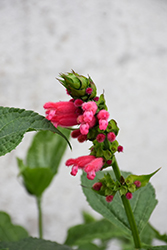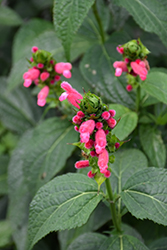Fri & Sat 8am - 8pm
Sun 8am - 7pm
Anytown, USA 12345
fax: 261.787.0463
e-mail: info@successgc.com


Plant Finder

Height: 5 feet
Spacing: 24 inches
Sunlight:
![]()
![]()
Hardiness Zone: 8b
Other Names: Bolivian Hummingbird Sage
Description:
A compact evergreen sub-shrub with glossy dark green, corrugated leaves covered in tiny hairs; clusters of vibrant, fuzzy, magenta flowers on spikes from late spring to fall; plant in groups, suitable for perennial borders and container use
Ornamental Features
Fuzzy Bolivian Sage has masses of beautiful spikes of hot pink tubular flowers with cherry red overtones rising above the foliage from late spring to mid fall, which emerge from distinctive dark red flower buds, and which are most effective when planted in groupings. The flowers are excellent for cutting. It has dark green foliage with light green veins. The large fuzzy heart-shaped leaves remain dark green throughout the winter.
Landscape Attributes
Fuzzy Bolivian Sage is a multi-stemmed evergreen shrub with an upright spreading habit of growth. Its average texture blends into the landscape, but can be balanced by one or two finer or coarser trees or shrubs for an effective composition.
This is a relatively low maintenance shrub. Trim off the flower heads after they fade and die to encourage more blooms late into the season. It is a good choice for attracting butterflies and hummingbirds to your yard, but is not particularly attractive to deer who tend to leave it alone in favor of tastier treats. Gardeners should be aware of the following characteristic(s) that may warrant special consideration;
- Suckering
Fuzzy Bolivian Sage is recommended for the following landscape applications;
- Mass Planting
- Border Edging
- General Garden Use
- Naturalizing And Woodland Gardens
- Container Planting
Planting & Growing
Fuzzy Bolivian Sage will grow to be about 4 feet tall at maturity, with a spread of 3 feet. When grown in masses or used as a bedding plant, individual plants should be spaced approximately 24 inches apart. It has a low canopy. It grows at a medium rate, and under ideal conditions can be expected to live for approximately 10 years.
This shrub does best in full sun to partial shade. It prefers to grow in average to moist conditions, and shouldn't be allowed to dry out. This plant should not require much in the way of fertilizing once established, although it may appreciate a shot of general-purpose fertilizer from time to time early in the growing season. It is not particular as to soil pH, but grows best in rich soils. It is somewhat tolerant of urban pollution. This species is not originally from North America. It can be propagated by cuttings.
Fuzzy Bolivian Sage makes a fine choice for the outdoor landscape, but it is also well-suited for use in outdoor pots and containers. With its upright habit of growth, it is best suited for use as a 'thriller' in the 'spiller-thriller-filler' container combination; plant it near the center of the pot, surrounded by smaller plants and those that spill over the edges. It is even sizeable enough that it can be grown alone in a suitable container. Note that when grown in a container, it may not perform exactly as indicated on the tag - this is to be expected. Also note that when growing plants in outdoor containers and baskets, they may require more frequent waterings than they would in the yard or garden.

